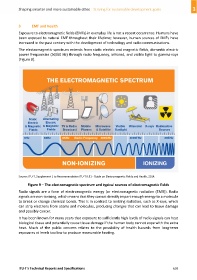Page 613 - Shaping smarter and more sustainable cities - Striving for sustainable development goals
P. 613
3 EMF and health
Exposure to electromagnetic fields (EMFs) in everyday life is not a recent occurrence. Humans have
been exposed to natural EMF throughout their lifetime; however, human sources of EMFs have
increased in the past century with the development of technology and radio communications.
The electromagnetic spectrum extends from static electric and magnetic fields, domestic electric
power frequencies (50/60 Hz) through radio frequency, infrared, and visible light to gamma‐rays
(Figure 9).
Source: ITU‐T, Supplement 1 to Recommendation ITU‐T K.91 ‐ Guide on Electromagnetic Fields and Health, 2014.
Figure 9 – The electromagnetic spectrum and typical sources of electromagnetic fields
Radio signals are a form of electromagnetic energy (or electromagnetic radiation (EMR)). Radio
signals are non‐ionizing, which means that they cannot directly impart enough energy to a molecule
to break or change chemical bonds. This is in contrast to ionizing radiation, such as X‐rays, which
can strip electrons from atoms and molecules, producing changes that can lead to tissue damage
and possibly cancer.
It has been known for many years that exposure to sufficiently high levels of radio signals can heat
biological tissue and potentially cause tissue damage if the human body cannot cope with the extra
heat. Much of the public concern relates to the possibility of health hazards from long‐term
exposures at levels too low to produce measurable heating.
ITU‐T's Technical Reports and Specifications 603

